Top Four Reasons to Travel to Bordeaux!
December 6, 2024
Bordeaux is well known for being the wine capital of the world, and with good reason. Bordeaux produces at least 400 million liters of -…
Read This PostIts coastline is famous, with thousands of years of history. Its white, chalky cliffs, turbulent seas, and sandy beaches have been the site of battles and voyages. And its food is some of the most quintessentially “French.”
Normandy is one of the most recognizable names of French regions. It is also one of the most popular destinations for our cooking vacations and cultural tours in France. But many do not fully appreciate its centuries of fascinating history.
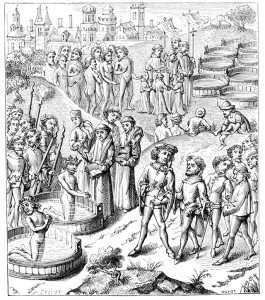 Normandy in the Time of the Romans
Normandy in the Time of the RomansNormandy was conquered in Roman times by Julius Caesar, who founded a city that became modern-day Rouen, as well as many other cities throughout the region that survive in some form to this day.
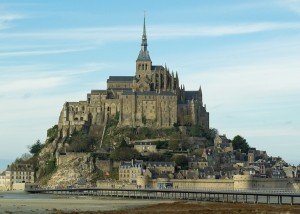 Discover Normandy on a cooking vacation.
Discover Normandy on a cooking vacation.
It was during Roman rule that Christianity found its way to region. This would result in some of Normandy’s most iconic sites. The cathedral of Rouen, which was built and rebuilt over a period of 800 years, represents in an incomparable mix of Gothic, Flamboyant, and Renaissance architecture. The abbey of Mont Saint Michele, founded in the year 708, is one of Europe’s most famous and recognizable sites.
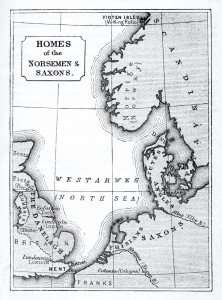 The Middle Ages
The Middle AgesIn the early Middle Ages the region was a battlefield between the Saxons and Germanic tribes, most notably the Franks. The Franks took control in the fifth century, and their rule reached its zenith with Charlemagne.
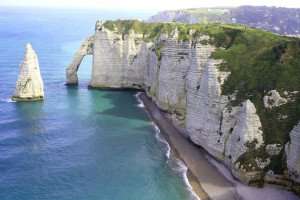 However, as one of the northernmost regions of France, Normandy’s position along the English channel meant access to invaders, including the Vikings, who were also called the “Northmen.” Eventually the Vikings, under Rollo the Viking, won the territory from the Franks. After a treaty in AD 911, they started settling the country in large numbers. These settlers became known as Normans, and the area known as Normandy.
However, as one of the northernmost regions of France, Normandy’s position along the English channel meant access to invaders, including the Vikings, who were also called the “Northmen.” Eventually the Vikings, under Rollo the Viking, won the territory from the Franks. After a treaty in AD 911, they started settling the country in large numbers. These settlers became known as Normans, and the area known as Normandy.
Five reasons to visit Normandy on a culinary vacation with TIK.
One of the most famous of Normans, William, Duke of Normandy, also known as William the Conqueror, successfully invaded England in 1066 at the Battle of Hastings. This event is immortalized in the famed Bayeux tapestry kept in the Cathedral of Bayeux.
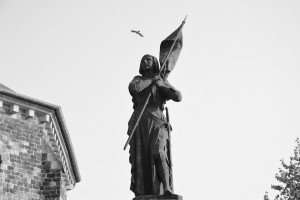 However, the union of Normandy and England under a single ruler became contested after William’s death. The various factions fought over Normandy for almost 400 years. Its rule fell to the Angevin empire, under the counts of Anjou, then to the French Capetian kings. Then it went back to the English before ending as a French territory in 1450 after the hundred year’s war. One famous event in Normandy during this period: the burning at the stake of Joan of Arc in the Old Market Square of Rouen in 1431.
However, the union of Normandy and England under a single ruler became contested after William’s death. The various factions fought over Normandy for almost 400 years. Its rule fell to the Angevin empire, under the counts of Anjou, then to the French Capetian kings. Then it went back to the English before ending as a French territory in 1450 after the hundred year’s war. One famous event in Normandy during this period: the burning at the stake of Joan of Arc in the Old Market Square of Rouen in 1431.
Normandy resurfaced, of course, as a sight of great battles some five hundred years later, when in the 20th century it was the location of the historic Allied invasion of German-occupied France known as “D-Day.” A visit to Normandy’s World War II battlefields, monuments, and cemeteries gives a sense of the scope of this endeavor in a way that nothing else can.
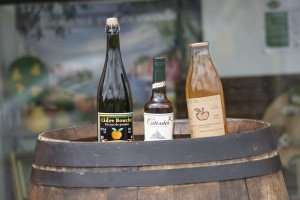 Normandy is still largely rural, with rolling fields in the interior and overlooking its famous coastlines. The rolling farmlands lend themselves to agriculture and the raising of livestock. The agriculture is responsible for one of Normandy’s most known products: apples; and the livestock for its other: cheese.
Normandy is still largely rural, with rolling fields in the interior and overlooking its famous coastlines. The rolling farmlands lend themselves to agriculture and the raising of livestock. The agriculture is responsible for one of Normandy’s most known products: apples; and the livestock for its other: cheese.
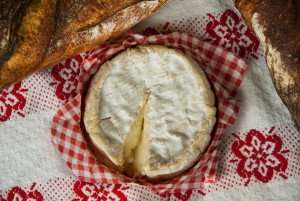 The department called Calvados is the center of apple production in Normandy. It gives its name to the region’s famous apple brandy, but is also the center of the region’s excellent cider production.
The department called Calvados is the center of apple production in Normandy. It gives its name to the region’s famous apple brandy, but is also the center of the region’s excellent cider production.
Camembert is king among French cheeses, but that is but one of the AOC dairy items produced in Normandy. In fact, in France something made “a la Normande” (or “Normandy-Style”) generally means with a creamy or buttery sauce. We’ve read that it is the temperate coastal climate that furnishes such good grazing for the cows and other livestock. Whether true or not, there is no denying the results in the world-famous cheeses like Camembert, Livarot, Neufchatel, and Pont-l’Eveque, as well as in the AOC butter, Beurre d’Isigny.
Try a recipe for prawns in garlic butter.
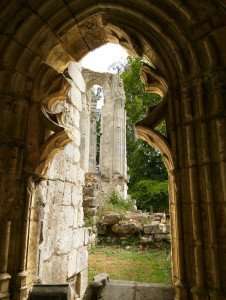 Why Normandy?
Why Normandy?To visit Normandy is like stepping back in time. Its medieval splendors rise from the foundations of the Romans and were built by each successive people that ruled there. The stunning Jumièges Abbey was begun in the 7th century, during the reign of Frank King Clovis II. It saw ruin at the hands of the vikings, and rebirth under the rule of William the Conqueror. Its impressive ruins today are one of the most visited sites in Normandy.
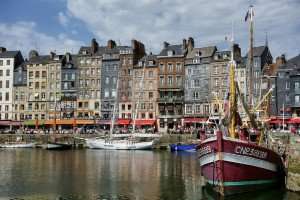 The great-great grandson of William the Conqueror, England’s Richard the Lionheart, built another of the region’s famous sites, the castle of Chateau-Gaillard.
The great-great grandson of William the Conqueror, England’s Richard the Lionheart, built another of the region’s famous sites, the castle of Chateau-Gaillard.
And peppered throughout the countryside are picturesque medieval villages such as Domfront, and characteristic half-timbered Norman villages like Beauron-en-Auge and Cormeilles. Not to mention, beautiful seaside towns like Honfleur and Bayeux.
Discover all our cooking vacations in France.
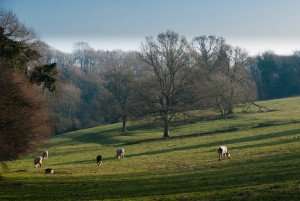 Normandy, in short, is there to explore. From the cliffs of Etretat to the WWII memorial at Omaha beach, from the fields of cattle on the Norman plains to the cathedral of Rouen. From the local bread oven in the village center, to the cider producer down the street.
Normandy, in short, is there to explore. From the cliffs of Etretat to the WWII memorial at Omaha beach, from the fields of cattle on the Norman plains to the cathedral of Rouen. From the local bread oven in the village center, to the cider producer down the street.
Explore it with us on a cooking vacation and culinary tour in Normandy, and discover this amazing land!
By Peg Kern
Sign up to receive our newsletter, which includes travel tips, recipes, promotions, and information on our best cooking vacations.
Find more photos, videos, food facts, and travel stories from The International Kitchen on Facebook, Instagram, Pinterest, Twitter, and YouTube.